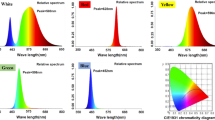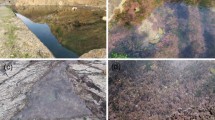Abstract
Holobionts are characterized by the relationship between host and their associated organisms such as the biofilm associated with macroalgae. Considering that light is essential to macroalgae survival, the aim of this study was to verify the effect of light on the heterotrophic activity in biofilms of the brown macroalgae Sargassum furcatum during its growth cycle. Measurements of heterotrophic activity were done under natural light levels at different times during a daily cycle and under an artificial extinction of natural light during the afternoon. We also measured Sargassum primary production under these light levels in the afternoon. Both measurements were done with and without photosynthesis inhibitor and antibiotics. Biofilm composition was mainly represented by bacteria but diatoms, cyanobacteria, and other organisms were also common. When a peak of diatom genera was recorded, the heterotrophic activity of the biofilm was higher. Heterotrophic activity was usually highest during the afternoon and the presence of a photosynthesis inhibitor caused an average reduction of 17% but there was no relationship with Sargassum primary production. These results indicate that autotrophic production in the biofilm was reduced by the inhibitor with consequences on bacterial activity. Heterotrophic activity was mainly bacterial and the antibiotics chloramphenicol and penicillin were more effective than streptomycin. We suggest primary producers in the biofilm are more important to increase bacterial activity than the macroalgae itself because of coherence of the peaks of heterotrophic and autotrophic activity in biofilm during the afternoon and the effects of autotrophic inhibitors on heterotrophic activity.




Similar content being viewed by others
References
Wahl M (1989) Marine epibiosis. 1. Fouling and antifouling—some basic aspects. Mar. Ecol. Prog. Ser. 58:175–189. doi:10.3354/meps058175
Armstrong E, Yan LM, Boyd KG, Wright PC, Burgess JG (2001) The symbiotic role of marine microbes on living surfaces. Hydrobiologia 461:37–40. doi:10.1023/a:1012756913566
Goecke F, Labes A, Wiese J, Imhoff JF (2010) Chemical interactions between marine macroalgae and bacteria. Marine Ecology-Progress Series 409:267–299. doi:10.3354/meps08607
Steinberg PD, Rice SA, Campbell AH, McDougald D, Harder T (2011) Interfaces between bacterial and eukaryotic "neuroecology". Integr. Comp. Biol. 51:794–806. doi:10.1093/icb/icr115
Haas AF, Wild C (2010) Composition analysis of organic matter released by cosmopolitan coral reef-associated green algae. Aquat. Biol. 10:131–138. doi:10.3354/ab00271
Lam C, Stang A, Harder T (2008) Planktonic bacteria and fungi are selectively eliminated by exposure to marine macroalgae in close proximity. FEMS Microbiol. Ecol. 63:283–291. doi:10.1111/j.1574-6941.2007.00426.x
Croft MT, Lawrence AD, Raux-Deery E, Warren MJ, Smith AG (2005) Algae acquire vitamin B-12 through a symbiotic relationship with bacteria. Nature 438:90–93. doi:10.1038/nature04056
Hollants J, Leliaert F, De Clerck O, Willems A (2013) What we can learn from sushi: a review on seaweed-bacterial associations. FEMS Microbiol. Ecol. 83:1–16. doi:10.1111/j.1574-6941.2012.01446.x
Bengtsson MM, Sjotun K, Lanzen A, Ovreas L (2012) Bacterial diversity in relation to secondary production and succession on surfaces of the kelp Laminaria hyperborea. ISME J. 6:2188–2198. doi:10.1038/ismej.2012.67
Coelho-Souza SA, Miranda MR, Salgado LT, Coutinho R, Guimaraes JRD (2013) Adaptation of the H-3-leucine incorporation technique to measure heterotrophic activity associated with biofilm on the blades of the seaweed Sargassum spp. Microb. Ecol. 65:424–436. doi:10.1007/s00248-012-0116-9
Coelho-Souza SA, Lopez MS, Davee Guimaraes JR, Coutinho R, Candella RN (2012) Biophysical interactions in the Cabo Frio upwelling system, southeastern Brazil. Braz. J. Oceanogr. 60:353–365
Coelho-Souza SA, Pereira GC, Coutinho R, Guimaraes JRD (2013) Yearly variation of bacterial production in the Arraial do Cabo protection area (Cabo Frio upwelling region): an evidence of anthropogenic pressure. Braz. J. Microbiol. 44:1349–1357
Ornellas AB, Coutinho R (1998) Spatial and temporal patterns of distribution and abundance of a tropical fish assemblage in a seasonal Sargassum bed, Cabo Frio Island, Brazil. J. Fish Biol. 53:198–208
Miranda MR, Guimaraes JRD, Coelho-Souza AS (2007) [H-3]Leucine incorporation method as a tool to measure secondary production by periphytic bacteria associated to the roots of floating aquatic macrophyte. J. Microbiol. Methods 71:23–31. doi:10.1016/j.mimet.2007.06.020
Parsons TR, Maita Y, Lalli M (1984) A manual of chemical and biological methods for seawater analysis. Pergamon Press, New York
Spilling K, Titelman J, Greve TM, Kuhl M (2010) Microsensor measurements of the external and internal microenvironment of Fucus vesiculosus (Phaeophyceae). J. Phycol. 46:1350–1355. doi:10.1111/j.1529-8817.2010.00894.x
Egan S, Harder T, Burke C, Steinberg P, Kjelleberg S, Thomas T (2013) The seaweed holobiont: understanding seaweed-bacteria interactions. FEMS Microbiol. Rev. 37:462–476. doi:10.1111/1574-6976.12011
Guimaraens MA, Goncalves JEA, Lourenco SO, Coutinho R (2008) Sensitivity analyses of population biomass dynamics for Ulva spp. and Sargassum furcatum at the Cabo Frio upwelling region of Brazil. J. Biol. Syst. 16:579–596
Coelho-Souza SA, Araujo FV, Cury JC, Jesus HE, Pereira GC, Guimaraes JRD, Peixoto RS, Davila AMR, Rosado AS (2015) Bacterial and archaeal communities variability associated with upwelling and anthropogenic pressures in the protection area of Arraial do Cabo (Cabo Frio region-RJ). Anais Da Academia Brasileira De Ciencias 87:1737–1750. doi:10.1590/0001-3765201520140098
Valentin JL (1984) Analysis of hydrobiological parameters in the Cabo Frio (Brazil) upwelling. Mar. Biol. 82:259–276
Plouguerne E, Hellio C, Cesconetto C, Thabard M, Mason K, Veron B, Pereira RC, da Gama BAP (2010) Antifouling activity as a function of population variation in Sargassum vulgare from the littoral of Rio de Janeiro (Brazil). J. Appl. Phycol. 22:717–724. doi:10.1007/s10811-010-9511-0
Duggins DO, Eckman JE (1997) Is kelp detritus a good food for suspension feeders? Effects of kelp species, age and secondary metabolites. Mar. Biol. 128:489–495. doi:10.1007/s002270050115
Cardinale BJ, Palmer MA (2002) Disturbance moderates biodiversity-ecosystem function relationships: experimental evidence from caddisflies in stream mesocosms. Ecology 83:1915–1927
Ellis CN, Traverse CC, Mayo-Smith L, Buskirk SW, Cooper VS (2015) Character displacement and the evolution of niche complementarity in a model biofilm community. Evolution 69:283–293. doi:10.1111/evo.12581
Lignell R (1990) Excretion of organic-carbon by phytoplankton—its relation to algal biomass, primary productivity and bacterial secondary productivity in the Baltic sea. Mar. Ecol. Prog. Ser. 68:85–99. doi:10.3354/meps068085
Hellio C, Marechal JP, Veron B, Bremer G, Clare AS, Le Gal Y (2004) Seasonal variation of antifouling activities of marine algae from the Brittany coast (France). Mar. Biotechnol. 6:67–82. doi:10.1007/s10126-003-0020-x
Hagstrom A, Larsson U (1984) Diel and seasonal variation in growth rates of pelagic bacteria. NATO Conference Series IV Marine Sciences 15:249–262
Romani AM, Sabater S (1999) Effect of primary producers on the heterotrophic metabolism of a stream biofilm. Freshw. Biol. 41:729–736. doi:10.1046/j.1365-2427.1999.00413.x
Isbell FI, Polley HW, Wilsey BJ (2009) Biodiversity, productivity and the temporal stability of productivity: patterns and processes. Ecol. Lett. 12:443–451. doi:10.1111/j.1461-0248.2009.01299.x
Nylund GM, Enge S, Pavia H (2013) Costs and benefits of chemical defence in the red alga Bonnemaisonia hamifera. Plos One:8. doi:10.1371/journal.pone.0061291
Skov MW, Volkelt-Igoe M, Hawkins SJ, Jesus B, Thompson RC, Doncaster CP (2010) Past and present grazing boosts the photo-autotrophic biomass of biofilms. Mar. Ecol. Prog. Ser. 401:101–111. doi:10.3354/meps08481
Costerton JW, Lewandowski Z, Caldwell DE, Korber DR, Lappinscott HM (1995) Microbial biofilms. Annu. Rev. Microbiol. 49:711–745
Nair S, Chandramohan D, Bharathi PAL (1992) Differential sensitivity of pigmented and nonpigmented marine-bacteria to metals and antibiotics. Water Res. 26:431–434
Hader DP, Kumar HD, Smith RC, Worrest RC (1998) Effects on aquatic ecosystems. Journal of Photochemistry and Photobiology B-Biology 46:53–68
Acknowledgements
We thank the IEAPM logistic support, especially to the Department of Oceanography (specially Antônio Casarin), the Department of Chemistry, Division of Biotechnology Lab team, and LEG 10 team. We also thank Ana Carolina Mazzuco, María Soledad López, Fernanda Siviero, Estevão de Souza, Dagles Viana dos Reis, and William Romão. Thank you for the comments from the anonymous referee that improved this manuscript. This work was supported by CAPES, CNPq, and FAPERJ.
Author information
Authors and Affiliations
Corresponding author
Electronic supplementary material
ESM 1
(GIF 243 kb)
Scanning electron microscopy images of biofilm on S. furcatum blades representing the typical biofilm appearance of each month: A – moderate bacterial density over the alga thallus, EPS was absent/rare, November (bar = 6 mm); B – lower bacterial and EPS density, December (bar = 6 mm); C –size of holes in biofilm increased, January (bar = 9 mm); D – high density of bacteria and diatoms on blade surface, note the increase of EPS over the thallus, February (bar = 4 mm); E – highest abundance of EPS on bottom portion of the blade, March (bar = 10 mm); F – algae tissue older, decrease of both microorganisms and EPS density was observed, April (bar = 1,5 mm). Leonardo T. Salgado, Instituto de Pesquisas Jardim Botânico do Rio de Janeiro (IPJBRJ)
Rights and permissions
About this article
Cite this article
Coelho-Souza, S.A., Jenkins, S.R., Casarin, A. et al. The Effect of Light on Bacterial Activity in a Seaweed Holobiont. Microb Ecol 74, 868–876 (2017). https://doi.org/10.1007/s00248-017-0995-x
Received:
Accepted:
Published:
Issue Date:
DOI: https://doi.org/10.1007/s00248-017-0995-x




